Skin Barrier Reinforcement Effect Assessment of a Spot-on Based on Natural Ingredients in a Dog Model of Tape Stripping
Abstract
Simple Summary
Abstract
1. Introduction
2. Materials and Methods
2.1. Study Timeline
2.2. Site Preparation
2.3. Measurements
2.4. Statistical Analysis
3. Results
3.1. Transepidermal Water Loss
3.2. Skin Surface Hydration
3.3. Adverse Effects
4. Discussion
5. Conclusions
Author Contributions
Funding
Institutional Review Board Statement
Informed Consent Statement
Data Availability Statement
Acknowledgments
Conflicts of Interest
References
- De Benedetto, A.; Rafaels, N.M.; McGirt, L.Y.; Ivanov, A.I.; Georas, S.N.; Cheadle, C.; Berger, A.E.; Zhang, K.; Vidyasagar, S.; Yoshida, T.; et al. Tight Junction Defects in Patients with Atopic Dermatitis. J. Allergy Clin. Immunol. 2011, 127, 773–786.e7. [Google Scholar] [CrossRef] [PubMed]
- Williams, M.R.; Gallo, R.L. The Role of the Skin Microbiome in Atopic Dermatitis. Curr. Allergy Asthma Rep. 2015, 15, 65. [Google Scholar] [CrossRef] [PubMed]
- Chermprapai, S.; Broere, F.; Gooris, G.; Schlotter, Y.M.; Rutten, V.P.M.G.; Bouwstra, J.A. Altered Lipid Properties of the Stratum Corneum in Canine Atopic Dermatitis. Biochim. Biophys. Acta Biomembr. 2018, 1860, 526–533. [Google Scholar] [CrossRef]
- Combarros, D.; Goudounèche, D.; Cadiergues, M.-C.; Simon, M. The Upper Epidermis of Atopic Dogs Is Altered at the Functional and Structural Levels. Vet. Dermatol. 2021, 32, 620-e165. [Google Scholar] [CrossRef] [PubMed]
- Olivry, T.; Paps, J.S.; Amalric, N. Transient and Reversible Reduction of Stratum Corneum Filaggrin Degradation Products after Allergen Challenge in Experimentally Mite-Sensitised Atopic Dogs. Vet. Dermatol. 2021, 33, 62. [Google Scholar] [CrossRef]
- Shimada, K.; Yoshihara, T.; Yamamoto, M.; Konno, K.; Momoi, Y.; Nishifuji, K.; Iwasaki, T. Transepidermal Water Loss (TEWL) Reflects Skin Barrier Function of Dog. J. Vet. Med. Sci. 2008, 70, 841–843. [Google Scholar] [CrossRef]
- Cobiella, D.; Archer, L.; Bohannon, M.; Santoro, D. Pilot Study Using Five Methods to Evaluate Skin Barrier Function in Healthy Dogs and in Dogs with Atopic Dermatitis. Vet. Dermatol. 2019, 30, 121-e34. [Google Scholar] [CrossRef] [PubMed]
- Momota, Y.; Shimada, K.; Noguchi, A.; Saito, A.; Nozawa, S.; Niina, A.; Tani, K.; Azakami, D.; Ishioka, K.; Sako, T. The Modified Corneocyte Surface Area Measurement as an Index of Epidermal Barrier Properties: Inverse Correlation with Transepidermal Water Loss. Vet. Dermatol. 2016, 27, 67-e19. [Google Scholar] [CrossRef] [PubMed]
- Pinkus, H. Examination of the Epidermis by the Strip Method of Removing Horny Layers. I. Observations on Thickness of the Horny Layer, and on Mitotic Activity after Stripping. J. Investig. Dermatol. 1951, 16, 383–386. [Google Scholar] [CrossRef] [PubMed]
- Vidémont, E.; Mariani, C.; Vidal, S.; Pin, D. Characterization of the Canine Skin Barrier Restoration Following Acute Disruption by Tape Stripping. Vet. Dermatol. 2012, 23, 103–109.e23. [Google Scholar] [CrossRef]
- Panzuti, P.; Vidémont, E.; Fantini, O.; Fardouet, L.; Noël, G.; Cappelle, J.; Pin, D. A Moisturizer Formulated with Glycerol and Propylene Glycol Accelerates the Recovery of Skin Barrier Function after Experimental Disruption in Dogs. Vet. Dermatol. 2020, 31, 344-e89. [Google Scholar] [CrossRef]
- Jung, J.; Nam, E.; Park, S.; Han, S.; Hwang, C. Clinical Use of a Ceramide-Based Moisturizer for Treating Dogs with Atopic Dermatitis. J. Vet. Sci. 2013, 14, 199–205. [Google Scholar] [CrossRef] [PubMed]
- Marsella, R.; Cornegliani, L.; Ozmen, I.; Bohannon, M.; Ahrens, K.; Santoro, D. Randomized, Double-Blinded, Placebo-Controlled Pilot Study on the Effects of Topical Blackcurrant Emulsion Enriched in Essential Fatty Acids, Ceramides and 18-Beta Glycyrrhetinic Acid on Clinical Signs and Skin Barrier Function in Dogs with Atopic Dermatitis. Vet. Dermatol. 2017, 28, 577-e140. [Google Scholar] [CrossRef] [PubMed]
- Hobi, S.; Klinger, C.; Classen, J.; Mueller, R.S. The Effects of a Topical Lipid Complex Therapy on Dogs with Atopic Dermatitis: A Double Blind, Randomized, Placebo-Controlled Study. Vet. Dermatol. 2017, 28, 369-e84. [Google Scholar] [CrossRef] [PubMed]
- Pin, D.; Bekrich, M.; Fantini, O.; Noel, G.; Vidémont, E. An Emulsion Restores the Skin Barrier by Decreasing the Skin PH and Inflammation in a Canine Experimental Model. J. Comp. Pathol. 2014, 151, 244–254. [Google Scholar] [CrossRef]
- Bensignor, E.; Videmont, E. Weekly Topical Therapy Based on Plant Extracts Combined with Lokivetmab in Canine Atopic Dermatitis. Vet. Dermatol. 2022, 33, 68-e22. [Google Scholar] [CrossRef]
- Marsella, R. Are Transepidermal Water Loss and Clinical Signs Correlated in Canine Atopic Dermatitis? A Compilation of Studies. Vet. Dermatol. 2012, 23, 238-e49. [Google Scholar] [CrossRef] [PubMed]
- Nuttall, T.J.; Marsella, R.; Rosenbaum, M.R.; Gonzales, A.J.; Fadok, V.A. Update on Pathogenesis, Diagnosis, and Treatment of Atopic Dermatitis in Dogs. J. Am. Vet. Med. Assoc. 2019, 254, 1291–1300. [Google Scholar] [CrossRef]
- Olivry, T. Is the Skin Barrier Abnormal in Dogs with Atopic Dermatitis? Vet. Immunol. Immunopathol. 2011, 144, 11–16. [Google Scholar] [CrossRef]
- Santoro, D.; Marsella, R.; Pucheu-Haston, C.M.; Eisenschenk, M.N.C.; Nuttall, T.; Bizikova, P. Review: Pathogenesis of Canine Atopic Dermatitis: Skin Barrier and Host-Micro-Organism Interaction. Vet. Dermatol. 2015, 26, 84-e25. [Google Scholar] [CrossRef] [PubMed]
- Fujimura, M.; Nakatsuji, Y.; Fujiwara, S.; Rème, C.; Gatto, H. Spot-on Skin Lipid Complex as an Adjunct Therapy in Dogs with Atopic Dermatitis: An Open Pilot Study. Vet. Med. Int. 2011, 2011, 281846. [Google Scholar] [CrossRef] [PubMed]
- Marsella, R.; Genovese, D.; Gilmer, L.; Ahrens, K.; Gatto, H.; Navarro, C. Investigations on the Effects of a Topical Ceramides-Containing Emulsion (Allerderm Spot on) on Clinical Signs and Skin Barrier Function in Dogs with Topic Dermatitis: A Double-Blinded, Randomized, Controlled Study. Int. J. Appl. Res. Vet. Med. 2013, 11, 110–116. [Google Scholar]
- Popa, I.; Remoue, N.; Osta, B.; Pin, D.; Gatto, H.; Haftek, M.; Portoukalian, J. The Lipid Alterations in the Stratum Corneum of Dogs with Atopic Dermatitis Are Alleviated by Topical Application of a Sphingolipid-Containing Emulsion. Clin. Exp. Dermatol. 2012, 37, 665–671. [Google Scholar] [CrossRef]
- Blaskovic, M.; Rosenkrantz, W.; Neuber, A.; Sauter-Louis, C.; Mueller, R.S. The Effect of a Spot-on Formulation Containing Polyunsaturated Fatty Acids and Essential Oils on Dogs with Atopic Dermatitis. Vet. J. 2014, 199, 39–43. [Google Scholar] [CrossRef][Green Version]
- Tretter, S.; Mueller, R.S. The Influence of Topical Unsaturated Fatty Acids and Essential Oils on Normal and Atopic Dogs. J. Am. Anim. Hosp. Assoc. 2011, 47, 236–240. [Google Scholar] [CrossRef] [PubMed]
- Glos, K.; Linek, M.; Loewenstein, C.; Mayer, U.; Mueller, R.S. The Efficacy of Commercially Available Veterinary Diets Recommended for Dogs with Atopic Dermatitis. Vet. Dermatol. 2008, 19, 280–287. [Google Scholar] [CrossRef] [PubMed]
- Abba, C.; Mussa, P.P.; Vercelli, A.; Raviri, G. Essential Fatty Acids Supplementation in Different-Stage Atopic Dogs Fed on a Controlled Diet. J. Anim. Physiol. Anim. Nutr. 2005, 89, 203–207. [Google Scholar] [CrossRef] [PubMed]
- Bensignor, E.; Morgan, D.M.; Nuttall, T. Efficacy of an Essential Fatty Acid-Enriched Diet in Managing Canine Atopic Dermatitis: A Randomized, Single-Blinded, Cross-over Study. Vet. Dermatol. 2008, 19, 156–162. [Google Scholar] [CrossRef]
- Boehm, T.M.S.A.; Klinger, C.J.; Udraite-Vovk, L.; Navarro, C.; Mueller, R.S. Clinical Effects of 2 Commercially Available Diets on Canine Atopic Dermatitis. Tierarztl. Prax. Ausg. K Kleintiere Heimtiere 2021, 49, 256–261. [Google Scholar] [CrossRef] [PubMed]
- Saevik, B.K.; Bergvall, K.; Holm, B.R.; Saijonmaa-Koulumies, L.E.; Hedhammar, A.; Larsen, S.; Kristensen, F. A Randomized, Controlled Study to Evaluate the Steroid Sparing Effect of Essential Fatty Acid Supplementation in the Treatment of Canine Atopic Dermatitis. Vet. Dermatol. 2004, 15, 137–145. [Google Scholar] [CrossRef]
- Combarros, D.; Castilla-Castaño, E.; Lecru, L.A.; Pressanti, C.; Amalric, N.; Cadiergues, M.C. A Prospective, Randomized, Double Blind, Placebo-Controlled Evaluation of the Effects of an n-3 Essential Fatty Acids Supplement (Agepi® Ω3) on Clinical Signs, and Fatty Acid Concentrations in the Erythrocyte Membrane, Hair Shafts and Skin Surface of Dogs with Poor Quality Coats. Prostaglandins Leukot. Essent. Fatty Acids 2020, 159, 102140. [Google Scholar] [CrossRef] [PubMed]
- Mueller, R.S.; Fettman, M.J.; Richardson, K.; Hansen, R.A.; Miller, A.; Magowitz, J.; Ogilvie, G.K. Plasma and Skin Concentrations of Polyunsaturated Fatty Acids before and after Supplementation with N-3 Fatty Acids in Dogs with Atopic Dermatitis. Am. J. Vet. Res. 2005, 66, 868–873. [Google Scholar] [CrossRef]
- Oh, W.-S.; Oh, T.-H. Mapping of the Dog Skin Based on Biophysical Measurements. Vet. Dermatol. 2010, 21, 367–372. [Google Scholar] [CrossRef]
- Darmon-Hadjaje, C.; Dellacasagrande, J.; Amalric, N. Effect of a Natural Spot-on Based on Phytoceramides, Plant-Extracted Essential Fatty Acids and Essential Oils on Reconstructed Canine Epidermis. Vet. Dermatol. 2021, 32, 419–433. [Google Scholar]
- Vaughn, A.R.; Branum, A.; Sivamani, R.K. Effects of Turmeric (Curcuma longa) on Skin Health: A Systematic Review of the Clinical Evidence. Phytother. Res. 2016, 30, 1243–1264. [Google Scholar] [CrossRef]
- Salehi, B.; Stojanović-Radić, Z.; Matejić, J.; Sharifi-Rad, M.; Anil Kumar, N.V.; Martins, N.; Sharifi-Rad, J. The Therapeutic Potential of Curcumin: A Review of Clinical Trials. Eur. J. Med. Chem. 2019, 163, 527–545. [Google Scholar] [CrossRef] [PubMed]
- Kim, K.; Jeon, H.M.; Choi, K.C.; Sung, G.Y. Testing the Effectiveness of Curcuma longa Leaf Extract on a Skin Equivalent Using a Pumpless Skin-on-a-Chip Model. Int. J. Mol. Sci. 2020, 21, 3898. [Google Scholar] [CrossRef] [PubMed]
- Rawal, R.C.; Shah, B.J.; Jayaraaman, A.M.; Jaiswal, V. Clinical Evaluation of an Indian Polyherbal Topical Formulation in the Management of Eczema. J. Altern. Complement. Med. 2009, 15, 669–672. [Google Scholar] [CrossRef] [PubMed]
- Fernández-Galleguillos, C.; Quesada-Romero, L.; Puerta, A.; Padrón, J.M.; Souza, E.; Romero-Parra, J.; Simirgiotis, M.J. UHPLC-MS Chemical Fingerprinting and Antioxidant, Antiproliferative, and Enzyme Inhibition Potential of Gaultheria Pumila Berries. Metabolites 2021, 11, 523. [Google Scholar] [CrossRef] [PubMed]
- Olszewska, M.A.; Owczarek, A.; Magiera, A.; Granica, S.; Michel, P. Screening for the Active Anti-Inflammatory and Antioxidant Polyphenols of Gaultheria Procumbens and Their Application for Standardisation: From Identification through Cellular Studies to Quantitative Determination. Int. J. Mol. Sci. 2021, 22, 11532. [Google Scholar] [CrossRef]
- Alam, F.; Saqib, Q.N.U.; Ashraf, M. Gaultheria Trichophylla (Royle): A Source of Minerals and Biologically Active Molecules, Its Antioxidant and Anti-Lipoxygenase Activities. BMC Complement. Altern. Med. 2017, 17, 3. [Google Scholar] [CrossRef]
- Liju, V.B.; Jeena, K.; Kuttan, R. An Evaluation of Antioxidant, Anti-Inflammatory, and Antinociceptive Activities of Essential Oil from Curcuma longa L. Indian J. Pharmacol. 2011, 43, 526–531. [Google Scholar] [CrossRef] [PubMed]
- Liu, W.-R.; Qiao, W.-L.; Liu, Z.-Z.; Wang, X.-H.; Jiang, R.; Li, S.-Y.; Shi, R.-B.; She, G.-M. Gaultheria: Phytochemical and Pharmacological Characteristics. Molecules 2013, 18, 12071–12108. [Google Scholar] [CrossRef] [PubMed]
- Nikolic, M.; Marković, T.; Mojović, M.; Pejin, B.; Savić, A.; Peric, T.; Marković, D.; Stevic, T.; Soković, M. Chemical Composition and Biological Activity of Gaultheria Procumbens, L. Essential Oil. Ind. Crops Prod. 2013, 49, 561–567. [Google Scholar] [CrossRef]
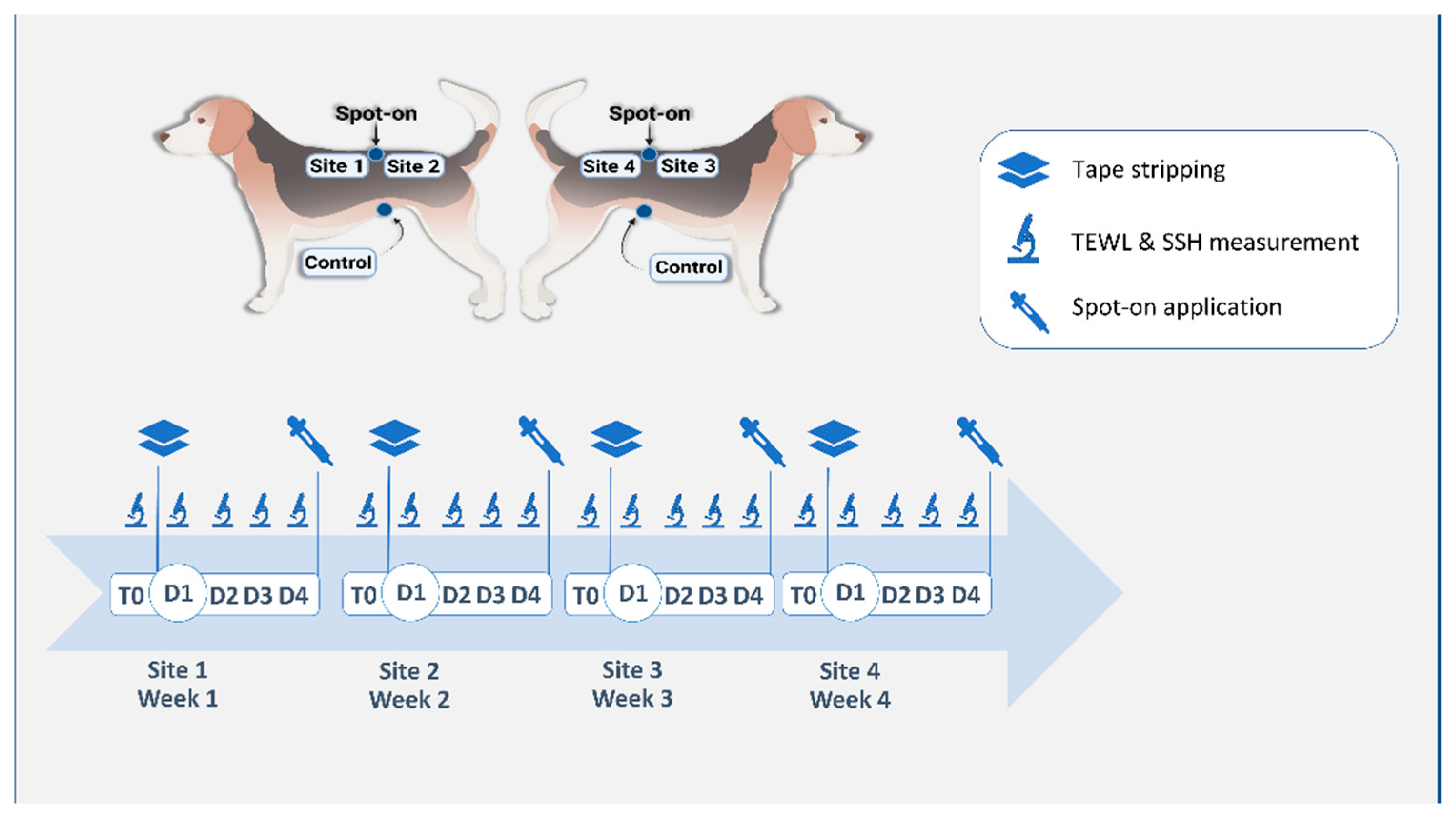
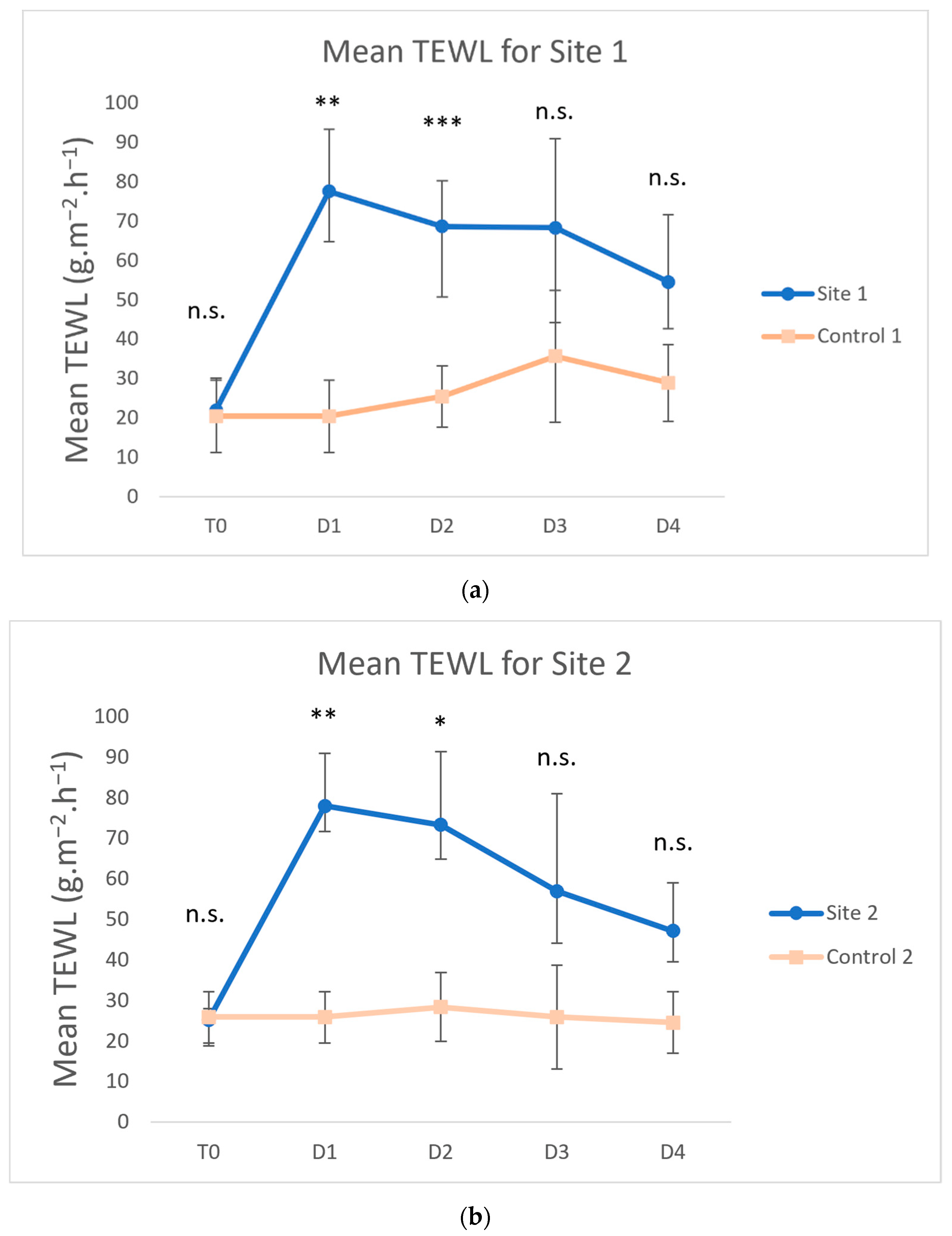
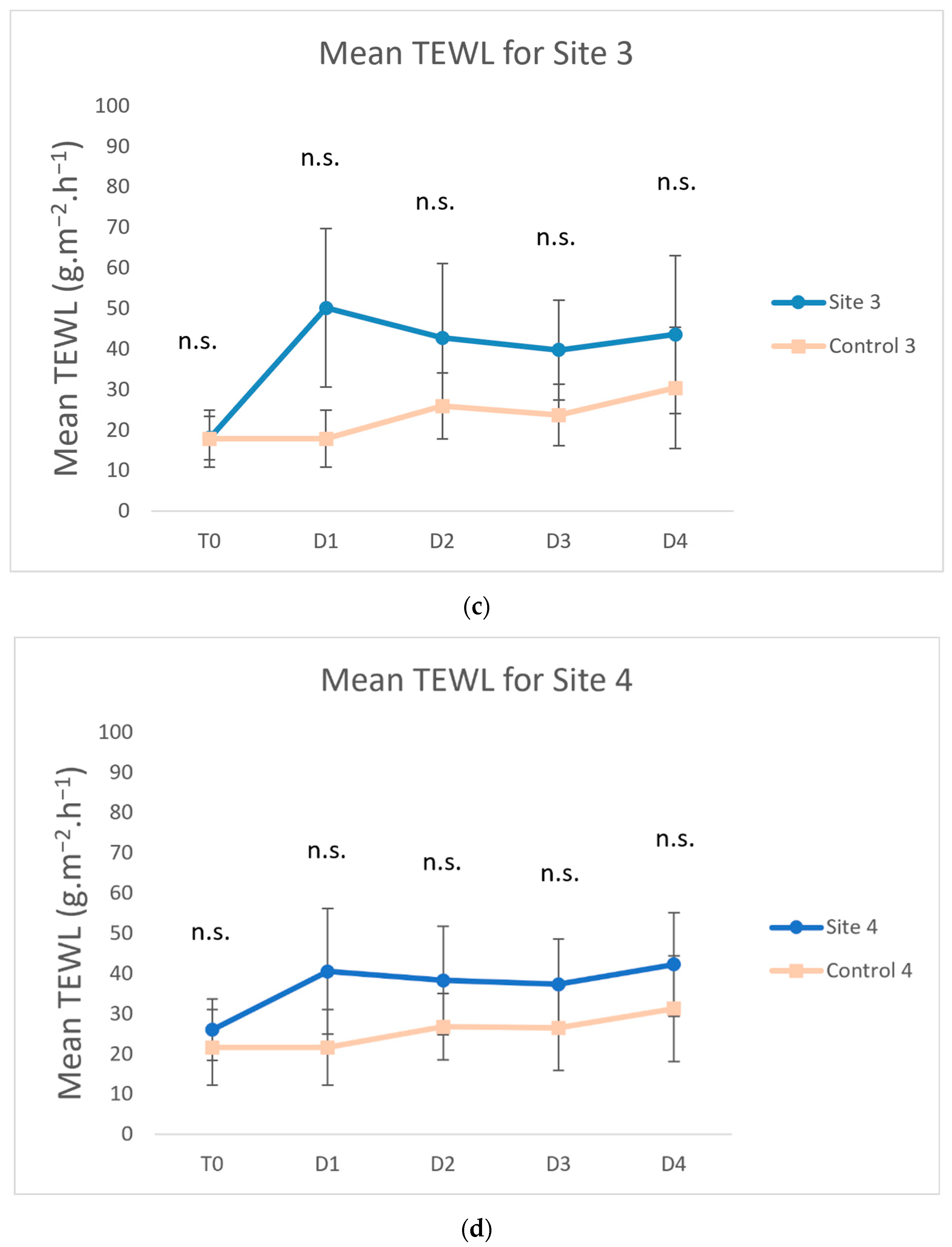
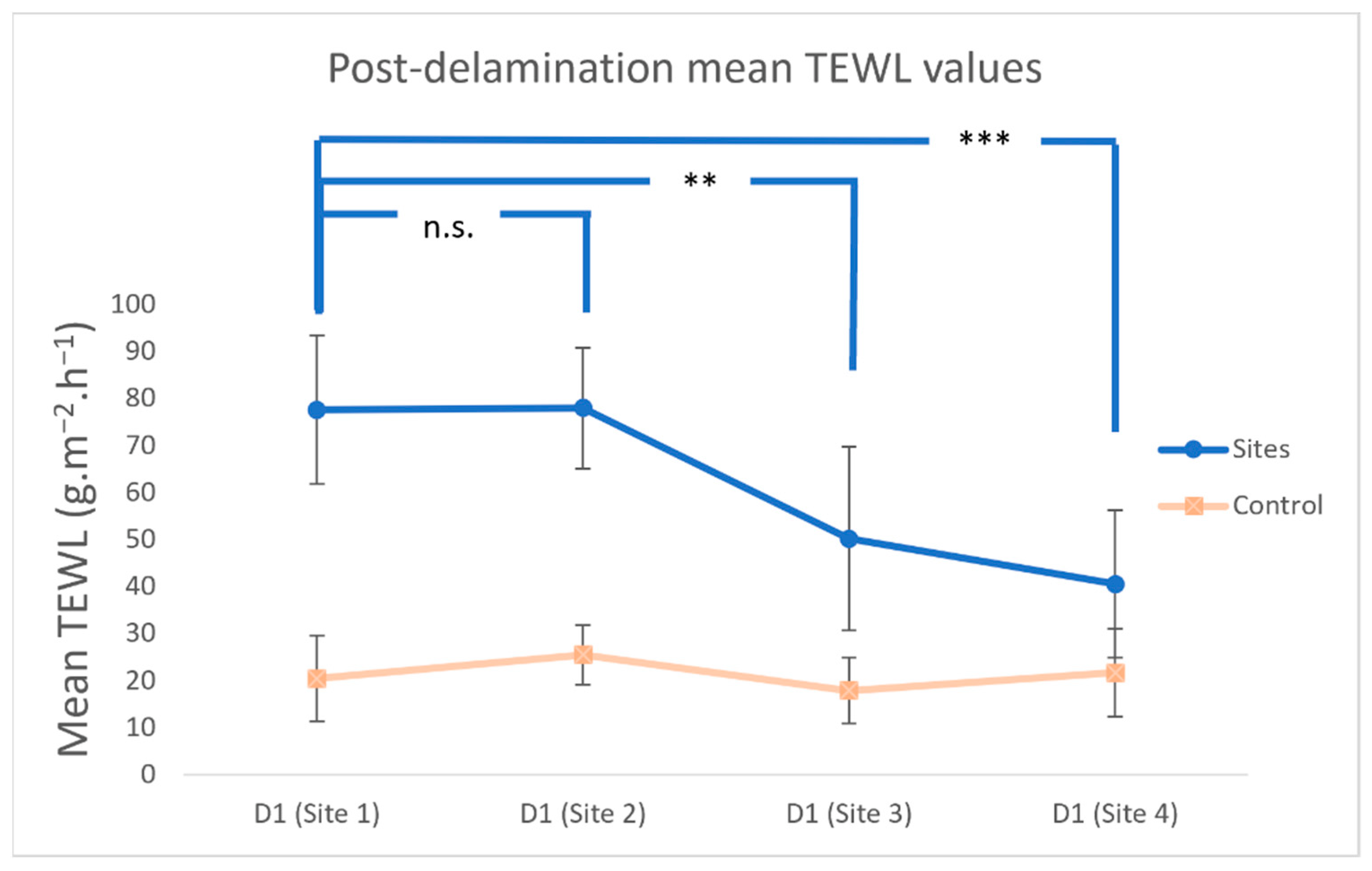


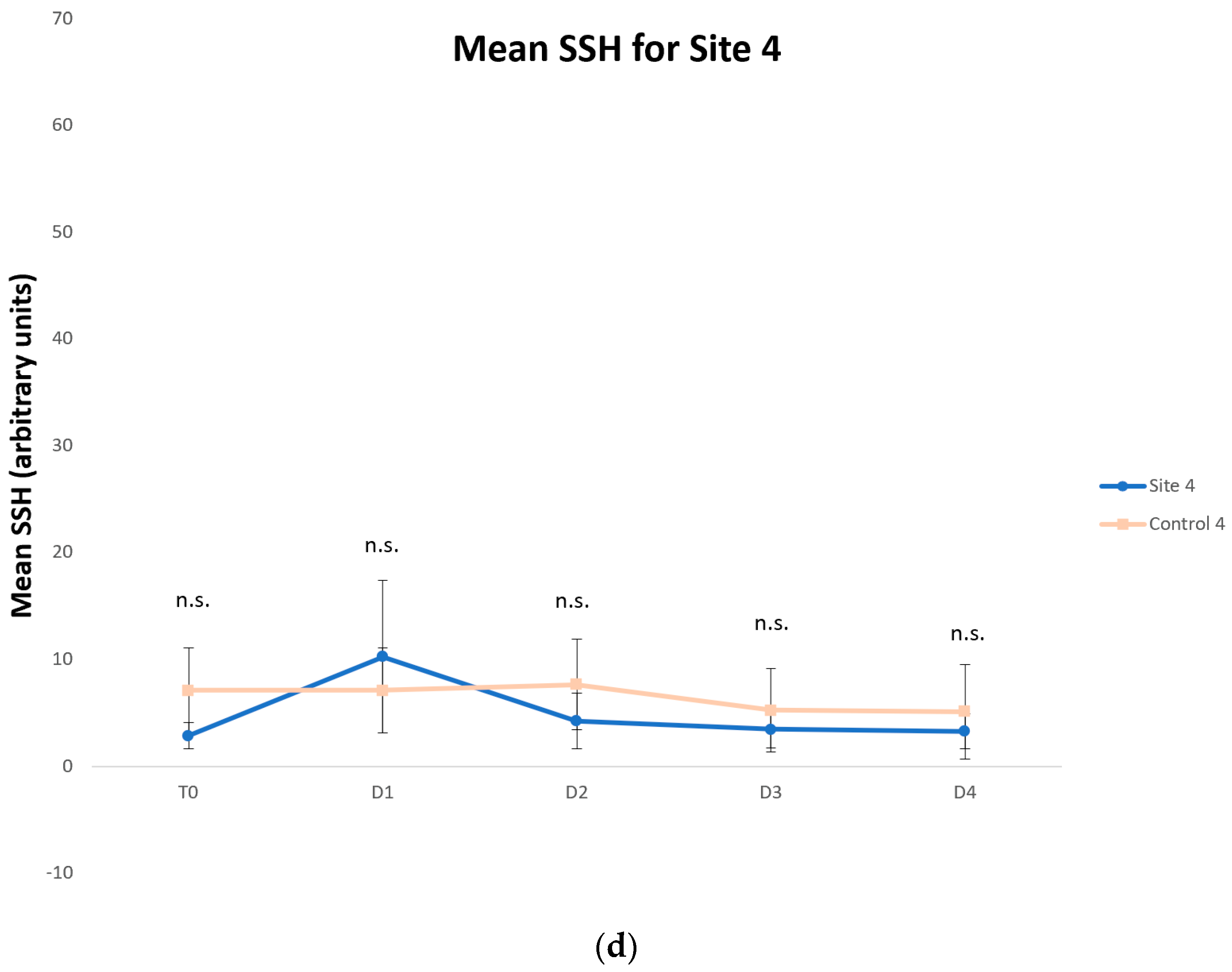
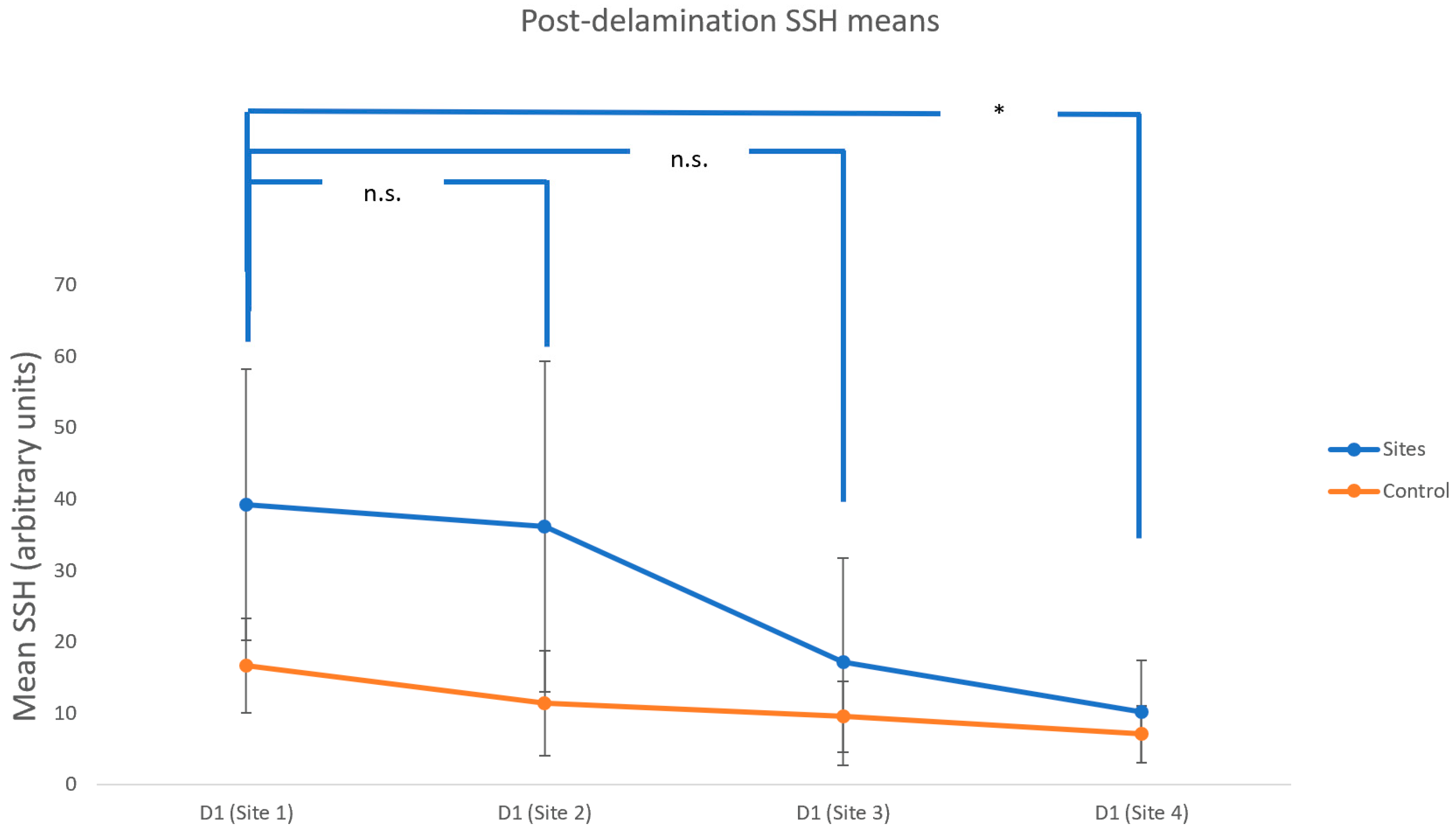
Publisher’s Note: MDPI stays neutral with regard to jurisdictional claims in published maps and institutional affiliations. |
© 2022 by the authors. Licensee MDPI, Basel, Switzerland. This article is an open access article distributed under the terms and conditions of the Creative Commons Attribution (CC BY) license (https://creativecommons.org/licenses/by/4.0/).
Share and Cite
Idée, A.; Mosca, M.; Pin, D. Skin Barrier Reinforcement Effect Assessment of a Spot-on Based on Natural Ingredients in a Dog Model of Tape Stripping. Vet. Sci. 2022, 9, 390. https://doi.org/10.3390/vetsci9080390
Idée A, Mosca M, Pin D. Skin Barrier Reinforcement Effect Assessment of a Spot-on Based on Natural Ingredients in a Dog Model of Tape Stripping. Veterinary Sciences. 2022; 9(8):390. https://doi.org/10.3390/vetsci9080390
Chicago/Turabian StyleIdée, Adrien, Marion Mosca, and Didier Pin. 2022. "Skin Barrier Reinforcement Effect Assessment of a Spot-on Based on Natural Ingredients in a Dog Model of Tape Stripping" Veterinary Sciences 9, no. 8: 390. https://doi.org/10.3390/vetsci9080390
APA StyleIdée, A., Mosca, M., & Pin, D. (2022). Skin Barrier Reinforcement Effect Assessment of a Spot-on Based on Natural Ingredients in a Dog Model of Tape Stripping. Veterinary Sciences, 9(8), 390. https://doi.org/10.3390/vetsci9080390






